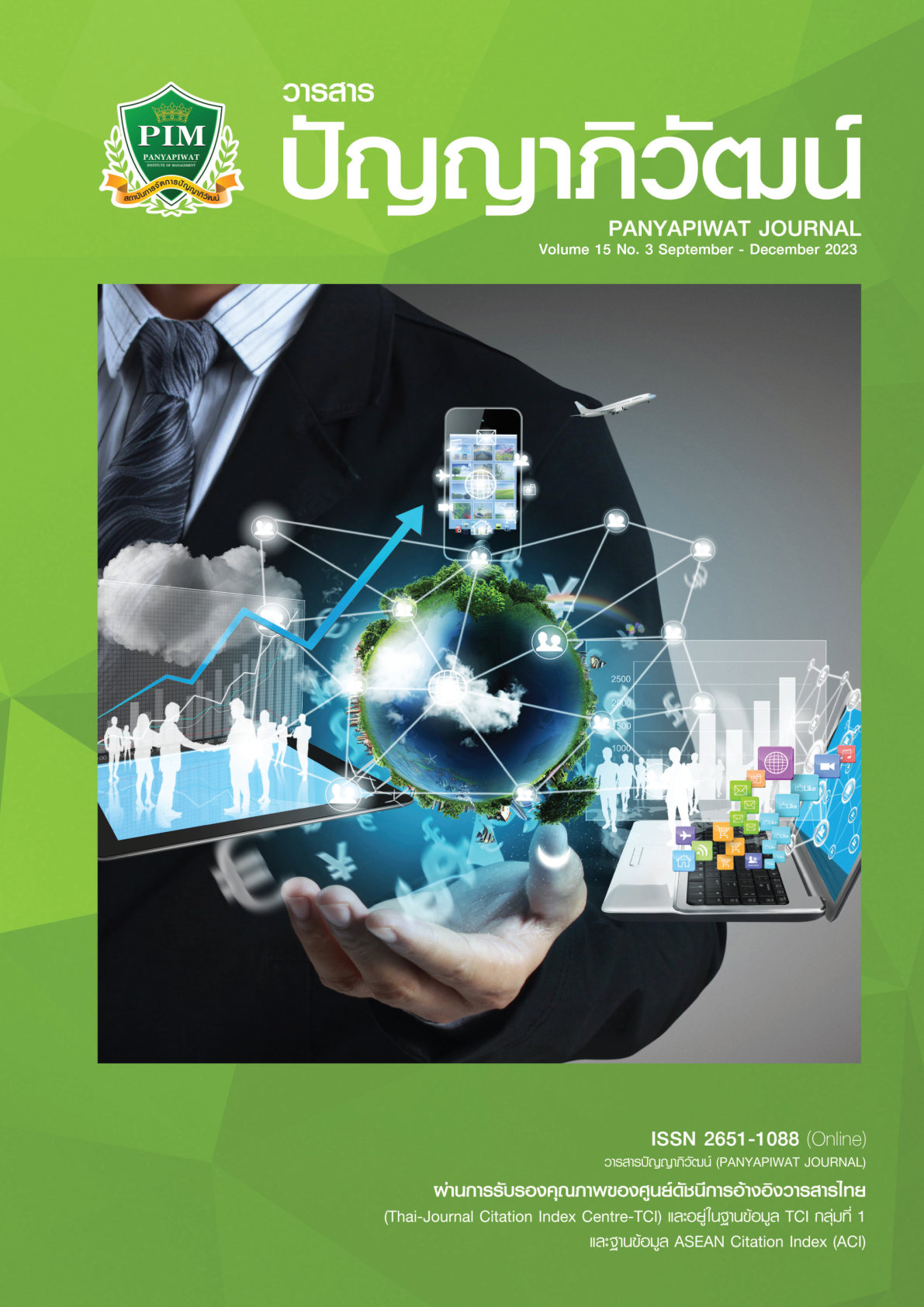การวิเคราะห์องค์ประกอบสมรรถนะการเป็นผู้ประกอบการผ้าทอมือ
Main Article Content
บทคัดย่อ
การพัฒนาผู้ประกอบการผ้าทอมือให้เป็นผู้มีความรู้ ชำนาญ และมีคุณลักษณะของการเป็นผู้ประกอบการ นอกจากจะเกิดประโยชน์โดยตรงผู้ประกอบการแล้ว ยังเป็นการสร้างรายได้กับชุมชนด้วย งานวิจัยนี้มีวัตถุประสงค์เพื่อศึกษาสมรรถนะการเป็นผู้ประกอบการผ้าทอมือ และวิเคราะห์องค์ประกอบสมรรนะการเป็นผู้ประกอบการผ้าทอมือ แบ่งการดำเนินการวิจัยออกเป็น 2 ระยะ ระยะที่ 1 ศึกษาสมรรถนะการเป็นผู้ประกอบการผ้าทอมือ จากการสัมภาษณ์ผู้ประกอบการผ้าทอมือที่ประสบความสำเร็จ จำนวน 18 คน โดยใช้แบบสัมภาษณ์เชิงลึก วิเคราะห์ข้อมูลด้วยการวิเคราะห์เนื้อหา และระยะที่ 2 วิเคราะห์องค์ประกอบสมรรถนะการเป็นผู้ประกอบการผ้าทอมือ ด้วยการวิเคราะห์องค์ประกอบเชิงสำรวจและการวิเคราะห์องค์ประกอบเชิงยืนยัน จากผู้ประกอบการผ้าทอมือจำนวน 1,029 คน เครื่องมือที่ใช้คือแบบสอบถามแบบมาตราส่วนประมาณค่า วิเคราะห์ข้อมูลด้วยโปรแกรมสำเร็จรูป
ผลการวิจัยพบว่า สมรรถนะการเป็นผู้ประกอบการผ้าทอมือประกอบด้วย 2 องค์ประกอบ ดังนี้ 1) องค์ประกอบสมรรถนะแกน ประกอบด้วย 4 ตัวแปร 1.1) การจัดการตนเองเพื่อพัฒนาการประกอบการผ้าทอมือ 1.2) การมุ่งผลสัมฤทธิ์เพื่อการประกอบการ 1.3) ความสามารถทางการตลาดและผลิตภัณฑ์1.4) ความรู้และความชำนาญในการทอผ้า 2) องค์ประกอบสมรรถนะทางวิชาชีพ ประกอบด้วย 3 ตัวแปร 2.1) การเป็นผู้นำและการทำงานร่วมกับผู้อื่น 2.2) การออกแบบและถ่ายทอดการสร้างสรรค์ผลิตภัณฑ์ผ้าทอมือ และ 2.3) ความรู้ความสามารถในการย้อมสีธรรมชาติและการบริการจัดการประกอบการผ้าทอมือองค์ประกอบสมรรถนะการเป็นผู้ประกอบการผ้าทอมือสามารถนำไปสร้างกิจกรรมหรือหลักสูตรสำหรับผู้ประกอบการผ้าทอมือต่อไป
Article Details

อนุญาตภายใต้เงื่อนไข Creative Commons Attribution-NonCommercial-NoDerivatives 4.0 International License.
“ข้าพเจ้าและผู้เขียนร่วม (ถ้ามี) ขอรับรองว่า บทความที่เสนอมานี้ยังไม่เคยได้รับการตีพิมพ์และไม่ได้อยู่ระหว่างกระบวนการพิจารณาลงตีพิมพ์ในวารสารหรือแหล่งเผยแพร่อื่นใด ข้าพเจ้าและผู้เขียนร่วมยอมรับหลักเกณฑ์การพิจารณาต้นฉบับ ทั้งยินยอมให้กองบรรณาธิการมีสิทธิ์พิจารณาและตรวจแก้ต้นฉบับได้ตามที่เห็นสมควร พร้อมนี้ขอมอบลิขสิทธิ์บทความที่ได้รับการตีพิมพ์ให้แก่สถาบันการจัดการปัญญาภิวัฒน์หากมีการฟ้องร้องเรื่องการละเมิดลิขสิทธิ์เกี่ยวกับภาพ กราฟ ข้อความส่วนใดส่วนหนึ่งและ/หรือข้อคิดเห็นที่ปรากฏในบทความข้าพเจ้าและผู้เขียนร่วมยินยอมรับผิดชอบแต่เพียงฝ่ายเดียว”
เอกสารอ้างอิง
Akera, R. (2022). The future entrepreneur for 4.0. VRU Research and Development Journal Science and Technology, 12(2), 79-88. [in Thai]
Bryant, J., & Poustie, K. (2001). Competencies needed by public library staff. Bertelsmann Foundation. http://uflibjobcompetencies.pbworks.com/f/Pub%20Lib%20Comp.pdf
Chaiwut, T., & Pongsatean, L. (2020). A guideline to promote competency that affects work efficiency personnel of the local government organization. HUSO Journal of Humanities and Social Sciences, 11(1), 135-150. [in Thai]
Chatnarongsak, S., & Jintakan, S. (2017). Conceptual framework of human resource development of an organization in the 21st century. Journal of Yala Rajabhat University, 12(Special), 168-184. [in Thai]
Chudhavipata, W. (2012). Textile: Reflection of Thai traditions. Dhurakij Pundit University. Community Development Department. (2022). Otop big data. https://otop.cdd.go.th/ [in Thai]
Cronbach, L. J., & Furby, L. (1970). How we should measure “change”: Or should we? Psychological Bulletin, 74(1), 68-80. https://doi.org/10.1037/h0029382
Department of Industrial Promotion. (2020 ). Annual project: Kon Phan R startup. https://www.dip.go.th/th/news/lists/2019-01-04-04-35-28
Hair, J. F., Jr., Anderson, R. E., Tatham, R. L., & Black, W. C. (1995). Multivariate data analysis. Macmillan Publishing Company.
Hair, J. F. Black, W. C., Babin, B. J., & Anderson, R. E. (2010). Multivariate data analysis: A global perspective (7th ed.). Pearson.
Lumpkin, G. T., & Dess, G. G. (1996). Clarifying the entrepreneurial orientation construct and linking it to performance. The Academy of Management Review, 21(1), 135-172. https:// doi.org/10.2307/258632
Majid, I. A., & Koe, W. L. (2012). Sustainable Entrepreneurship (SE): A revised model based on Triple Bottom Line (TBL). International Journal of Academic Research in Business and Social Sciences, 2(6), 293-310.
McClelland, D. C. (1973). Testing for competency rather than for intelligence. American Psychologist, 28(1), 1-14
Miller, D. (1983). The correlates of entrepreneurship in three types of firms. Management Science, 29(7), 770-791.
Nara, K. (2020). Concept of entrepreneurial mindset development. Journal of the Association of Researchers, 25(3), 278-290. [in Thai]
National Strategy 2018-2037. (2021, December 13). The government Gazette. Vol. 135 parts 82 kor 13 octoter 2021. 1-74. [in Thai]
Onuoha, G. (2007). Entrepreneurship. AIST International Journal, 10, 20-32.
Personal Communication no.2. (2020, December 19). Interviewed by O. Mongkondaw [Tape recording]. IMPACT Arena, Exhibition and Convention Center, Nonthaburi.
Personal Communication no.7. (2020, December 19). Interviewed by O. Mongkondaw [Tape recording]. IMPACT Arena, Exhibition and Convention Center, Nonthaburi.
Phonprasert, W. (2011). Strategic management concept. In Strategic Management in Health Development (pp. 1-62). Sukothai Thammathirat Open University. https://www.stou. ac.th/Schools/Shs/upload/%E0%B8%AB%E0%B8%99%E0%B9%88%E0%B8%A7%E0%B8%A2% E0%B8%97%E0%B8%B5%E0%B9%88%201.pdf [in Thai]
Sakwarawit, A. (2004). Competency: The old story we lost. Chulalongkorn Review, 16(1), 57-72. [in Thai]
Spencer L. M., McClelland D. C., & Spencer, S. M. (1994). Competency assessment methods: History and state of the art. Hay/McBer Research Press.
Sustainable Arts and Crafts Institute of Thailand (Public Organization). (2021). Export arts and crafts products annual report 2021. https://www.sacit.or.th/th/detail/2021-04-23-15-37-22 [in Thai]
The Office of SMEs Promotion. (2018). Annual report 2018. http://sme.go.th [in Thai]
The Office of SMEs Promotion. (2020). Annual report 2020. http://sme.go.th [in Thai]
Trade Policy and Strategy Office. (2018). Future of Thai-Textile…pro and corn? TPSO Journal, 2(9), 5.
Udomsri, A., Kraichan, P., & Roopsing, T. (2021). The model of competency development of spa operators. Technical Education Journal King Monkut’s University of Technology North Bangkok, 12(1), 91-100. [in Thai]
Viratchai, N. (2012). The Linear Relationship (LISREL): Statistic for social science and behavioral sciences. Department of Educational Research and Psychology, Faculty of Education, Chulalongkorn University. [in Thai]
Yenthong, H. B. (2015). The problems of Mud Mee Silk Weaving Groups in Tambon Sri Boon Rueang of Chonnabot District Khon Kaen Province. Warasand Karn Borikarn Thongth in Thai, 9(1), 100-117. [in Thai]


